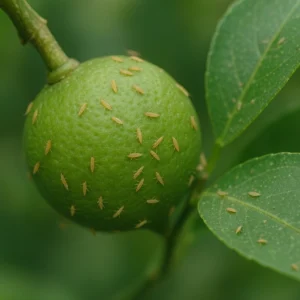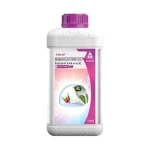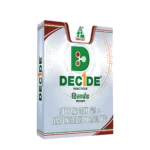Acid Lime Pests
Thrips

Symptoms
Leaf Damage:
- Silvery or Bronze Discoloration: Thrips feeding results in silvery or bronze streaks or patches on leaves due to the empty plant cells left behind. This discoloration is often more apparent on the upper surfaces of leaves.
- Leaf Curling and Distortion: Prolonged feeding can cause leaves to curl, distort, or develop a rough texture. New growth is particularly susceptible to this damage.
- Stunted Growth: Heavy infestations can lead to stunted growth as the plant diverts resources to repair damaged tissue.
Flower and Fruit Damage:
- Deformed Flowers: Thrips feeding on flower buds can lead to deformed or discolored flowers, reducing fruit set and yield.
- Scarring on Fruit: Thrips feeding on developing fruits can cause surface scarring, which may appear as silvery or brown streaks or rough patches. This damage can affect the appearance and marketability of the fruit.
- Premature Fruit Drop: In severe cases, heavy infestations can cause flowers and young fruits to drop prematurely.
Indirect Effects:
- Disease Transmission: Some thrips species can transmit plant viruses, such as Tomato spotted wilt virus (TSWV), though this is less common in citrus.
Identification
- Appearance: Adult thrips are very small, typically 1-2 mm in length. They are slender insects with two pairs of fringed wings. The color of thrips can vary, but they are often yellow, brown, or black.
- Behavior: Thrips are active and agile, often found on the undersides of leaves or within flowers. They feed by piercing plant cells and sucking out their contents, causing direct damage to plant tissues.
Nymphs (Immature Thrips):
- Appearance: Nymphs are similar in shape to adults but smaller and usually lighter in color (often pale yellow or white).
- Behavior: Nymphs are also active feeders and are typically found in the same areas as adults, such as leaf undersides and flower buds.
Management
- Reflective Mulches: Reflective mulches (silver-colored) can deter thrips from landing on plants by confusing them with reflected light. These mulches can be placed around the base of citrus trees.
- Sticky Traps: Blue or yellow sticky traps can be used to monitor and reduce adult thrips populations. Place these traps near affected plants to capture flying thrips.
- Predatory Insects: Introduce or encourage natural predators such as minute pirate bugs (Orius spp.), lacewing larvae (Chrysoperla spp.), and predatory mites (Amblyseius spp.), which feed on thrips and can help reduce their populations.
|
Insecticide |
Dosage |
|---|---|
|
0.5 gm/lit |
|
|
0.5 ml/lit |
₹310
Select options
This product has multiple variants. The options may be chosen on the product page
₹723
Select options
This product has multiple variants. The options may be chosen on the product page


